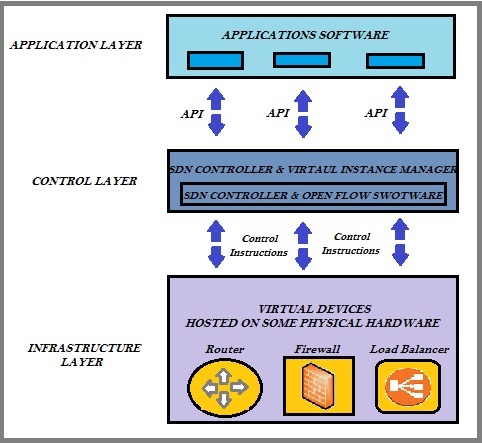What is SDN-NFV
To understand SDN let's recollect how the traditional or existing networks operate and what are constraints related to such networks.
Let's take example of a well established service provider that has thousands of networking equipment (routers, switches, firewalls etc)connected in the network.
SDN (Software-defined Networking) provides us a new way of operating, controlling, and configuring the network devices. This means that SDN will help in controlling and managing the network devices through softwares(controllers) instead of controlling the devices through consoles, remote consoles, CLI, which require lot of Administrative overhead(Time/resources/cost).
Let's take example of a well established service provider that has thousands of networking equipment (routers, switches, firewalls etc)connected in the network.
- The equipment have both the control and data plane hosted in same chassis. An issue in control plane or data plane would affect the complete network device and the customer services running on/through it.
- After a specific period of time, each device needs software/hardware up-gradation that involves lots of Opex and Capex.
- Again, new software/hardware is prone to be affected by new bugs, network vulnerabilities, which is service disruptive and again needs software/hardware fix. This increases Vendor dependency.
- Vendor dependency involves continuous follow up until permanent resolution and ultimately increases delay in service restoration.
SDN (Software-defined Networking) provides us a new way of operating, controlling, and configuring the network devices. This means that SDN will help in controlling and managing the network devices through softwares(controllers) instead of controlling the devices through consoles, remote consoles, CLI, which require lot of Administrative overhead(Time/resources/cost).
SDN Advantages
- Software Defined Networking (SDN) is a new technology to drive the networks.SDN technology separates the control plane from the data plane(or forwarding plane) by moving the control plane to a centralized location.
- With the help of SDN we can configure, control, maintain, and program data plane state from a central entity/location. This centralized entity has capability to operate the entire service provider network(all connected devices) from a single location.
- Using SDN, Control plane & Data Plane can be run on general purpose/commodity hardware/servers.
- Reduces Overall Capex and Opex.
- SDN will provide agility and flexibility to the organizations to rapidly deploy new applications, services, and infrastructure to quickly meet changing business goals and objectives.
To conclude as of now, SDN is set of
network instructions/control polices to be executed through a
centralized controller(Hardware+ Related Software). These instructions
are set of rules for the distributed virtual devices (For example:
Virtual Firewalls, Virtual Load Balancers, Virtual traffic Shapers etc.)
that will guide them for operation.
SDN Architecture (Layers)
- The Application Layer (Softwares to interact with Control Layer).
- The Control Layer (Softwares to interact with Hardware Devices in Infrastructure Layer, for example, VIM and SDN Controller are used to defined control policies).
- The Infrastructure Layer (Kind of Data Center where the physical devices are placed/hosting the Virtual devices).
We need separate software which is
generally called Virtual Instance Manager that will also reside at the
Control Layer (along with SDN Controller Software) and will help in
reserving, allocating the required resources (CPU/RAM/HDD etc.) for
creating a Virtual instances of devices (say Firewall, Load Balancers
etc.).Once these virtual device instances are ready to be operated, we can host a service over these virtual devices.
In Nutshell, when the customer
services are bind with virtual devices, that is generally call Network Function Virtualization(NFV).
A Useful Example to understand SDN/NFV concept
Say, customer needs an L3 MPLS VPN Connection. We generally create a VRF instance on the PE for that customer say “ABC_Net”.
We have a Physical Router say at Infrastructure Layer. We cannot dedicate complete PE to customer “ABC_Net”, therefore we create a virtual instance using VRF.
Now how should we create a VRF and related config. Here comes the Role of Virtual Instance Manager which resides at Control Layer
through which you configure/Reserve resources for a Virtual router for
the customer. We need software to login/remotely loging into the
Physical router. Say we use Putty tool which resides at Application Layer through which we will access the Physical router. Telnet is say the API to login into the physical router/device.
Say, you have created a VRF
“ABC_Net”, bound it with the CE facing interface, and created an ipv4
address-family instance for that VRF. Now a kind of Virtual Router is
ready.
Now comes the role of SDN Controller which also resides at Control layer to define the Routing policies, Network advertisements, BGP control Policies under the customer routing instance.
After defining the Routing policies,
say Customer CE connectivity to the PE (VRF) comes up and customer is
ready to run his services through this CE-PE VPN connectivity.
Customer running his services (Voice/Video/Data) through this virtual router hosted on the PE is referred as NFV






